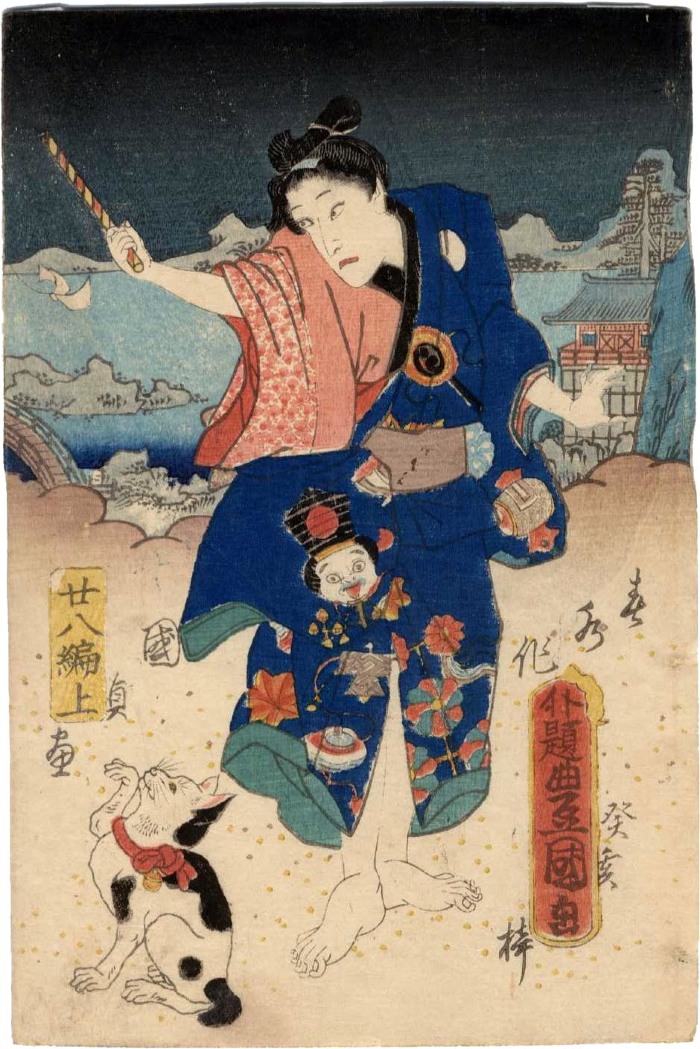Utagawa Kunisada (歌川国貞) / Toyokuni III (三代豊国) (artist 1786 – 01/12/1865)
Chapter 28 (ehon) cover from the Hokusetsu bidan jidai kagami ('Uplifting Tale of Northern Snows' Mirror of the Ages - 北雪美談時代加々見) - right-hand panel of a pair
ca 1855
4.75 in x 7 in (Overall dimensions) Japanese color woodblock print
Signed: Kunisada ga (国貞画)
Noda Library - the full set
Waseda University Library A boy, his robe decorated with images of children's toys, teases a cat. One of the toys is a 'yajirobei' (弥次郎兵衛) or balancing toy with long arms. Another is a 'sanbasō' mask with its tongue sticking out. Others include a spinning top or 'koma' (独楽), a pinwheel (風車), a lucky mallet or 'Uchida no kozuchi' (打ち出の小槌), et al.
The children's toys seen on this figures robes serve two different purposes: on the one hand they operate simply as toys, but on the other they were thought to be talismen that warded off diseases such as smallpox. Often images of these and other things were printed in red ink only and placed strategically in rooms where small children slept.
****
What is with the sanbasō mask with its tongue sticking out?
In Volume 3 of the Kabuki Plays on Stage: Darkness and Desire, 14-1864 there is a section called 'Sanbasō with His Tongue Stuck Out' Shitadashi Sanbasō with a brief history of this motif. Nakamura Utaemon III brought it to the kabuki stage in 1812 as an "...homage to the great actor-dancer Nakamura Nakazō I (1736-90)."
"Nakazō's Sanbasō dance was distinctive not only for its Shigayama-school style, but because Sanbasō stuck out his tongue in one section. It is said that Nakazō imitated a traditional child's toy, modeled after a humorous character's head whose tongue sticks out when a string is pulled. when Sanbasō, absorbed in the joy of his dance, sticks out his tongue, it greatly enhances his comic charm. This tongue-sticking-out business also became an important part of Nakazō's villain roles, where the tongue is painted bright red for emphasis.... Sticking out the ongue may also incorporate a spell to ward off evil spirits."
****
The publisher is Wakasaya Yoichi (Marks 573). The original story was written by Tamenaga Shunsui II (為永春水: 1818-86) and published between 1855-83.
There is a bit of somewhat contradictory information about the authorship of these volumes on page 222 in James King's Japanese Woodblock Prints: Artists, Publishers and Masterworks 1680-1900: "Wakasaya was also engaged in publishing illustrated books. In 1855, he started to produce the first volumes of the serial novel. “Northern Snows, a Gorgeous Tale and Mirror of Our Times” (Hokusetsu bidan jidai kagami), his most successful publication. Written by Tamenaga Shunshō (1822–1886), it was first illustrated by Kunisada, then by then by Kunisada II and Ginkō, the last volume appeared in 1882."
Andrew Lawrence Markus wrote in footnote #104 in The Willow in Autumn: Ryūtei Tanehiko, 1783-1842 that "Among the lavish late Edo and early Meiji serial gōkan bestsellers partially inspired by the success of Inaka Genji figure Jiraiya gōketsu monogatari (Tale of Jiraiya the hero, 1839-1868?), Shiranui monogatari (The tale of Shiranui, 1849-1883?), [Hokusetsu bidan] Jidai kagami (Uplifting tale of northern snows: Mirror of the ages; 1855-1883)..."
Wakasaya Yoichi (若狹屋与市) (publisher)
picture book (ehon - 絵本) (genre)
Tamenaga Shunsui I and II (為永春水) (author)
